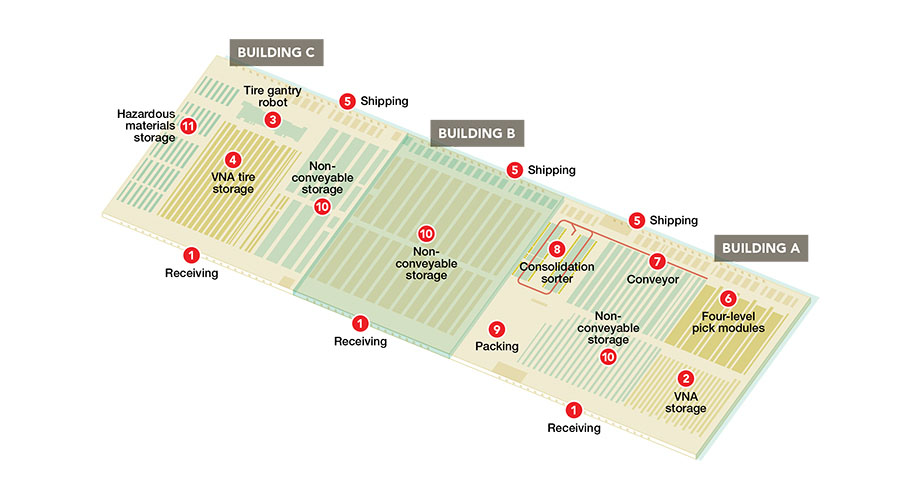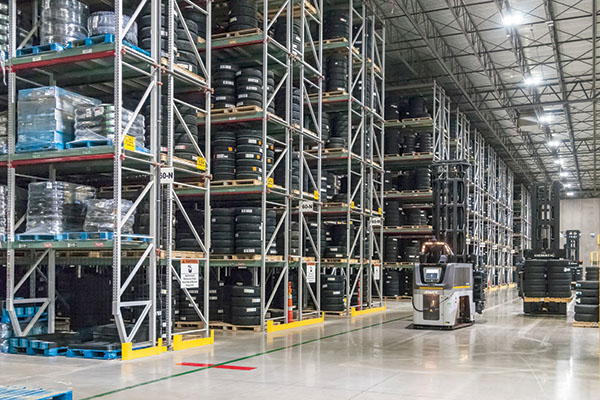Inside Canadian Tire Distribution Center: Design for flexibility
Canadian Tire’s bulk handling facility brings together automation and conventional materials handling for a variety of products.
Canadian Tire - Bolton Distribution Centre - Caledon, Ontario
Read the full editorial System Report for more information on the distribution center.
Square Footage: 1.45 million square feet
Products Handled: Tires and bulk general merchandise including tools, sporting goods, home living, automotive and seasonal outdoors products
SKUS: 15,500
Throughput: 350 trailers a day, 65 million cubic feet of shipments per year
Shifts: Two 10-hour shifts per day/7 days per week
Canadian Tire’s new bulk handling distribution center is three distinct warehouses in one. Building A is a highly automated area for items that can be conveyed in their packaging or can be placed in a tote. Building B is designated for the fastest-moving items, as well as some oversized non-conveyables, like swimming pools, trampolines and televisions. Building C includes a 250,000-square-foot area for robotic tire handling as well as conventional handling of long, large or heavy items, such as canoes, hockey sticks or snow blowers. Hazardous and flammable items are also stored in Building C. Each building was designed to maximize the efficient handling of the products managed in each location.

Receiving and putaway
Receiving for Buildings A, B & C (1) is manual. With the exception of tires, which have their own receiving and order fulfillment processes, items are received into a proprietary warehouse management system (WMS) and then palletized. Conveyable items that weigh less than 50 pounds are picked up by pallet-handling fork automatic guided vehicles (AGVs) and delivered to staging locations in Building A. Very narrow aisle (VNA) AGVs put the pallets away into a storage location (2). The VNA AGVs are also used to retrieve pallets to replenish pick modules.
Pallets for the other two buildings are delivered by lift trucks and put away into a designated floor or rack location (10). Heavy items, or those with unusual configurations like water heaters, are handled with clamp trucks.
Tire receiving, picking and shipping
In Building C, tires are manually unloaded onto an extendable conveyor for delivery to the robotic tire-handling and storage area (3). As tires exit the truck, a fixed camera-imaging scanner reads the bar code label. Based on the scan, tires are diverted by SKU to one of two lanes. If there is current demand for an SKU, the overhead tire-handling gantry robot places the required number of tires on a cart. Each cart holds a store order. Otherwise, the robot palletizes the tires for reserve storage (4). When a pallet is ready for storage, a VNA AGV picks up the pallet and automatically puts it away into a storage location. Using task interleaving, the VNA AGV can also retrieve a pallet to fill a store order. That pallet is delivered to a picking location, and the gantry robot picks the required number to a cart. Once all of the items for a store order have been picked, the cart is released from the robot and is delivered by a tugger to a staging area in shipping (5). A tugger can move up to four carts at a time.
Building A picking and shipping
Picking instructions are delivered by voice to associates working in one of the five four-level pick modules (6). The different levels are connected by spiral conveyor. Larger, bulkier items are placed directly on conveyor, while smaller items are placed in totes. The conveyor is wider than standard conveyor to accommodate larger items. The items are transported to a consolidation sorter along a 3-mile long transport conveyor (7) installed on a mezzanine that runs the length of Building A. Items weighing less than 15 pounds go down a conventional chute to packing (9). Heavier items weighing up to 50 pounds are sorted to chutes with motor driven roller conveyor to control the descent of the items to packing. There are a total of 150 chutes, with a heavy and light chute assigned to a store.
Once the chute is full, a light directs a packer with a tablet and RFID scanner to scan an item to a pallet or roller cage. Full pallets and cages are transported by AGV to the shipping area (5). At the dock, the AGV picks up empty pallets and cages and delivers them as needed back to the sortation/packing area. The WMS ensures that items for that store from Buildings B and C arrive a nearly the same time to allow for efficient trailer loading.
Buildings B and C picking and shipping
Buildings B and C use similar picking processes. Some items will be picked with clamp trucks; others will be picked to single or double pallet handling trucks. The WMS creates a pick path based on the weight of the product, with the heaviest items going on the bottom of the pallet. Associates receive picking instructions over their voice headsets and travel to the appropriate pick location within storage (10). While voice is used in the area designed for the storage of oxidizers and aerosols (11), in the area designed for flammables, associates receive instructions on fork-mounted mobile computers to avoid sparks. Once all of the items for that task have been picked, the pallets are delivered to shipping (5) where they are married up with other items for a specific store.
Shipping
Once loading begins, shippers load full pallets or are adding product that needs to be consolidated to cube out a trailer (5).
Read the full editorial System Report for more information on the distribution center.













